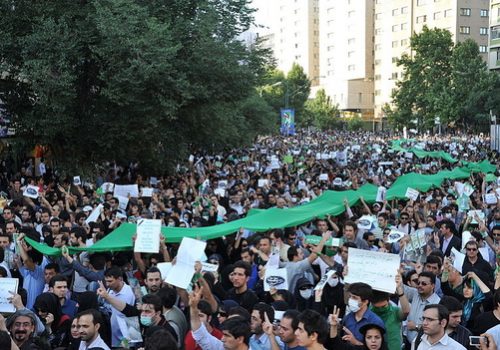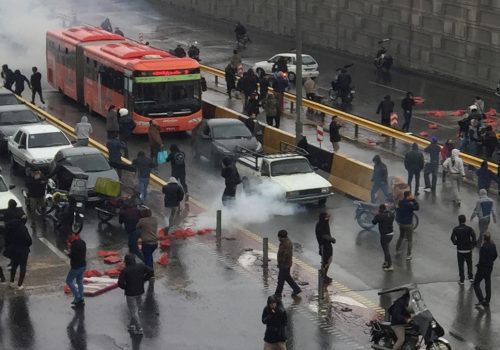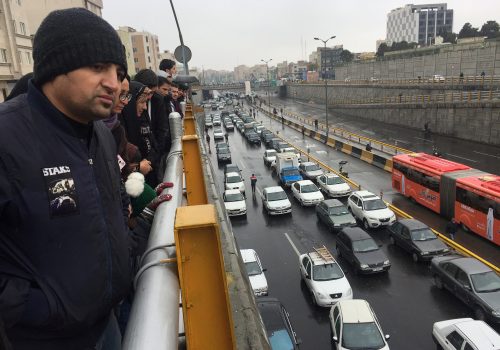Perennial repression, mourning, and despair consume Iran
In the last three months, estimates ranging from hundreds to several thousand Iranians have been killed and arrested inside Iran.
Beginning with the latest major unrest in the Islamic Republic’s history, in November 2019, Iran would see week-long protests erupt across the country. The series of civil protests, initially due to the tripling of fuel prices transforming into anti-government protests about corruption and a desire for reform, saw the highest rate of violence and repression by the government since the 1979 Islamic Revolution. Hundreds of individuals were reportedly killed, countless arrested, coupled with a nation-wide internet blackout.
The January 3 assassination of Iran’s top General, Qasem Soleimani, sent Iranians back to the streets—this time to mourn the killing of someone they saw as a national hero. The three-day funeral procession allowed tens of thousands to grieve publicly, against the backdrop of government-sanctioned violence two months prior. Traditionally, pro-government Iranians are bused into cities for major gatherings. However, these crowds were considerably large on their own without government intervention. US President Donald Trump’s threat to target 52 Iranian sites, including cultural sites, should Iran retaliate for the Soleimani killing, was another factor in bringing out the sizable crowds. What was to be a ‘rally round the flag’ moment for the Islamic Republic due to the general’s popularity would soon be overshadowed by the death of 59 mourners and hundreds of others injured during a stampede at the commander’s funeral procession in Kerman, his hometown.
On January 8, Iran’s Supreme Leader Ayatollah Ali Khamenei delivered on his promise of “harsh revenge.” The Islamic Revolutionary Guard Corps (IRGC) launched over a dozen ballistic missiles at two Iraqi bases housing US troops but resulted in no casualties. During the nightlong operation, a Ukrainian civilian airliner was shot down near Tehran’s Imam Khomeini Airport, killing all 176 people on board. Iranian authorities immediately claimed that the airplane had a mechanical failure, leading the plane to crash only minutes after take-off. Canada was particularly invested in learning the truth about the cause of the crash as it had lost 57 citizens on Ukraine International Airlines Flight 752. Evidence provided by US authorities, as well as continuous pressure from the international community to run a transparent investigation and release the black box to American company Boeing, led to the admission by Tehran that the plane had been struck in error by an anti-aircraft missile system.
In the minds of many Iranians, this was the excesses, cruelty, and persistent mismanagement of the Islamic Republic on full display again. It was an avoidable tragedy that ended up claiming the lives of some of Iran’s best and brightest, many of which had moved to the west to seek better opportunities. The tragedy also emphasized that the first victims of escalated tensions between the US and Iran were ordinary Iranian civilians. They paid for the conflict with their blood.
The timing of the crash, as well as the initial official denial, give this catastrophe special resonance at a time when Iran’s leaders continue their standoff against the United States and its campaign of ‘maximum pressure’ on Tehran.
As government officials pleaded for unity and solidarity, on January 11, Iranians held candlelight vigils for those who lost their lives on Flight 752. The following day, Iranians across a dozen cities—including Tehran, Isfahan, and Rasht—as well as several major universities held rallies, chanting anti-governmental and anti-clerical slogans, similar to those heard in November 2019 and during the December 2017 – January 2018 protests.
“Mullahs must get lost,” “IRGC have some shame, let the country go,” and “death to Velayat-e Faqih [rule of the Islamic jurist]” were among the chants.
At Tehran’s Sharif University, students cheered when one called out, “Be sure that if this wasn’t an international airplane, we’d never know the truth.”
Notable this time around were several anti-Soleimani chants, including “Soleimani is a murderer; His leader is also a murderer, His regime is obsolete.”
As domestic unrest amongst its population of 82 million continues to ebb and flow, the Iranian government also feels the crushing economic pressure from the US-led sanctions regime. With more than 1.6 million Iranians sliding into poverty since the re-imposition of US sanctions in early 2018, and the economy slated to shrink by 9.5 percent in 2020, the despair markedly increases the likelihood of protests. Every major demonstration is a face-off with security forces. Renewed vigor is met time and time again with matched suppression and violence.
As the government feels this dual pressure, it is likely to continue responding with its newest tyrannical tool: internet blackouts to halt the spread of information in hopes of stifling demonstrations and reducing the amount of news leaving the country.
On January 17, Supreme Leader Ayatollah Ali Khamenei delivered the Friday prayer sermon in Tehran. He made clear there will be neither change nor reform, only the reinforcement of the strident policies of the Islamic Republic: continued domestic repression at any cost and no compromise with the United States.
The Iranian government, feeling cornered by the international community and its people, will use its deep-rooted anti-imperialist nationalism to justify the crackdowns—particularly on the heels of what it considers the martyrdom of its great general and continued threats of war by President Trump.
Throughout the past decade, Iran’s rulers have consistently chosen repression and the use of deadly force in lieu of cooperation with their countrymen, especially when dealing with dissidents as well as ethnic and religious minorities.
As desperation mounts, Iranians feel pressured from every direction—economically, politically, and militarily—exacerbated by the ever-present challenges of climate change, evident most recently with devastating floods in Iran’s Sistan and Baluchistan province.
Demonstrations, counter-demonstrations, and repression are likely to reappear with the February 11 anniversary of the Islamic Revolution, and parliamentary elections on February 21. With no hint of reform on the horizon, they will remain a component of an unstable Islamic Republic of Iran.
Masoud Mostajabi is an assistant director of the Middle East Programs at the Atlantic Council. On Twitter @MMostajabi1.
Image: Debris of the Ukraine International Airlines on the outskirts of Tehran on January 8, 2020 (Reuters)


